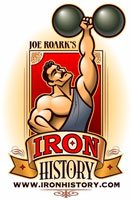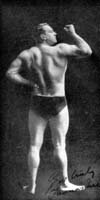
INCH 101: Part 18
On Sep. 26, 1871 Ivan Padoubny was born. Inch claimed to have left the Inch 172 lb bell at Hengler's Circus while Padoubny was wrestling there, which, as near as I can determine may have been 1908 because there was a wrestling tournament going on there then and Padoubny faced Apollon on Feb. 10, 12, and 18th.
Ivan defeated Apollon in a controversial match, and it is my studied view that Inch heard of this defeat and Apollon's angry withdrawal from the tournament, and brought the bell by Hengler's when Apollon was absent. This most certainly fits if Inch brought the bell by between Feb. 12th and 18th (Apollon returning on the 18th) - Padoubny was 36, Apollon age 46.
Inch certainly knew better than to give Apollon a chance, especially a challenge, in regard to the 172. Apollon had a famous block weight with a ring, the total which weighed 176 lbs which he often used, so he would have scoffed at the 172. Inch avoided this.
This scenario works if one of the three time tables presented is accepted. The bell was left at Hengler's for one day, one week, or two weeks. One day is likely because one week would have encompassed Apollon's return, and even though at age 46 he might not outwrestle Ivan, no one would assert Ivan's lifting was anywhere in the neighborhood of Apollon's.
When did Inch or other writers first refer to this Hengler's situation above? Miller mentioned it in April 1936, in Strength & Health, and three years later in that mag., Inch himself wrote of it. Then Inch again wrote of it in Strength & Health on Dec. 20, 1956.
When did Padoubny die: 1949. I have never found a response from Ivan about the Hengler's/Inch bell claim. Has anyone reading this seen any text from Ivan about the incident?

INCH 101: Part 19
In H&S Oct. 10, 1931, Inch recounts details of his June 3, 1911, match with Edward Aston. Please keep in mind that whatever amount of weight you can successfully clean with one arm on a standard 1" diameter bar, will be considerably more than you can one arm clean on a bar with 2.38" diameter. With that in mind, think about the implications for Inch's strength levels before this match when he wrote:
-
"When I state that I had lost form so completely that I only managed 210 lb two hands clean, 170 one hand clean, and under 200 bent press, it will be recognized that no expert would have taken 100 to 1 upon my chance of defeating Aston."
If 170 lbs on a 1" bar was his limit at about that time in the one arm clean, then only the ignorant would claim he could add two pounds to the weight and add 1.38" to the bar diameter, thus having his challenge bell specs, and be able to clean it.
He of course gained strength, but the point here is that for whatever amount of time he had descended to his lower level of strength, then he was unable to clean the Inch 172 using only one hand. Keeping in mind that he had introduced the 172 in 1907, then sometime within the next four years he lost the ability to clean it.
Before the match mentioned above, he began training a few weeks ahead, of course. By match-time he was able to clean 210 lbs and 10 ounces on a 1" bar with one hand. Still, as we now know, due to the prevalence of Inch sized handles and Inch replicas - a WORLD away from cleaning the thick handled 172. Indeed, if all you can clean is 210 on a standard bar, you will not be able to get the Inch OFF the floor!
Of course, he never used the word "clean" in reference to the bell in that era; he always wrote about "lifting" it - which could mean simply deadlifting it. He used words cleverly.
In H&S Oct. 21, 1933, reference is made to an article in the Oct. 7 issue; Inch writes: "Sir: In the Oct. 7 issue, in Mr. Valentine's article, reference is made to my performance at Leeds. Lest there be any misapprehension regarding what he described was a challenge dumbbell, I wish to make it clear that I was using my competition dumbbell and not the challenge dumbbell, which for thirty years has withstood every effort of challengers to lift it off the ground."
So for 30 years - means that the challenge bell (172 lbs, 2.38" diameter handle) had been around since 1903? More likely 1906, but perhaps Inch was generalizing the date.
Of course some of this confusion can be traced directly to the doorstep of Mr. Inch, who for many years did not reveal the existence of his four identical-looking but vastly differently weighted bells: 75, 140, 153, and 172.
I have an Inch that weighs 152 and one that weighs 172. From more than six feet away it is very difficult to distinguish which bell is 20 lbs lighter. If a person were in the audience, he would have NO chance of this discernment. The hollow 75, and the solid 140 also appeared to be the same size.
So Inch's trickery over the years, in which, after he lifted one of the lighter bells, he would, later in the program offer his challenge, and bring out on to the stage the 172, which was not the bell he lifted, but the unknowing audience thought it was. So, when, Fairbrother and Spacey and Chowles were able to lift the competition bell off the floor, a clarification was needed from Inch to protect his reputation, because many assumed that the bell was the bell that Inch had called his challenge bell all those years.
How much did the competition bell weigh? About 140 lbs.

INCH 101: Part 20
On Oct. 19, 1957, Inch had his bell at the Mr. Universe contest in London. He was age 75 then, though the report in H&S says 76, "This great old timer who has trod the pages of strongmanism for many years got a lot of praise and a good deal of laughter from the appreciative audience. Scottish lifter John Gallacher (sic) got the prize for the best attempt."
In H&S Oct. 21, 1933, page 500, Inch writes to the mag. to clarify that the bell used recently at Leeds was NOT the challenge (172) bell, but the competition (140) bell. He further claims that the 172: "for 30 years has withstood every effort of challengers to lift it from the ground."
Other passages from the mags indicate otherwise, of course, but perhaps Inch was banking on what many writers bank on- the ignorance of the reader regarding the history of the situation being discussed. 30 years would indicate that the 172 had been around since 1903. Perhaps Inch was speaking in general terms, because it appears the 172 was not manufactured until circa 1906.
Oct. 22, 1929: was the day Inch performed a two dumbbells anyhow of 276 lbs via 220 in one hand and 56 in the other - this at age 47. Also in Inch's dumbbell competition, a man named Newman won with four reps in the jerk. This would be the 140 lb. bell not the 172, and two hands were allowed to clean the bell.
| IRON HISTORY IN FEBRUARY | ||||
|
||||
I am uncertain when Inch first retired the 172 - it appears to have been 1931, even though he had been holding his competitions with the 140 before that time. And he may have brought the 172 out of retirement during World War II, but that is also vague.
Oct. 19, 1957: Now to add confusion comes the 153 lb Inch bell, affectionately known as the middleweight dumbbell (are we to infer there were three bells, and that this at 153 was "midway" from the 140 to the 172? Only rarely does Inch mention his 75 lb. hollow bell.
Please keep in mind that the 172 had a handle with a diameter of 2.38", but the others may have had 2.47 or 2.5 inches in diameter - hardly discernable with the naked eye from a distance of a few feet. I'm rambling - so to the point.
"The Inch middleweight dumbbell [(153 lbs)] was then brought on and only two men, John Gallacher [(John Gallagher?)] and Jacobus Jacobs, succeeding in lifting it off the floor - John lifting as high as the thighs. Later backstage however, Jacobs lay on the floor, pulled it on to his chest, stood up and then hoisted it over his head. This info from the Reg Park Journal, which shortly thereafter mentioned the weight at 155, not 153 lbs, and said the handle was 2.25". Give me strength!
Further, "The heavyweight [172] Inch dumbbell is now in our warehouse for all to attempt," Park offered. Also at the warehouse was the Inch practice handle, which remains in the possession of David Prowse to this day.
Oct. 25, 1910: Inch was among those present to start the formation of the British Weight-Lifters' Association. He was elected chairman of the pro division, and Tom Pevier served in that capacity for the amateurs.
For 1911 and 1912 the following were named as the official lifts for amateurs: Right Hand Clean, with jerk or bent press allowed from the shoulder. Same with left hand. And, the Two Hands Clean and Jerk with Barbell.
This article in The British Amateur Weightlifter and Bodybuilder also traces the split between the pro and amateurs sections and how the names evolved. By the way, 3 months later Inch was elected Treasurer of the Pro division.






 Last Date
Last Date

